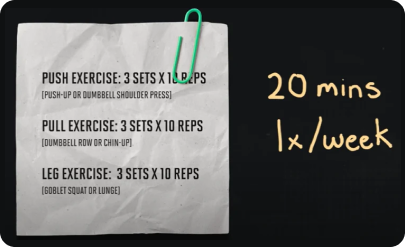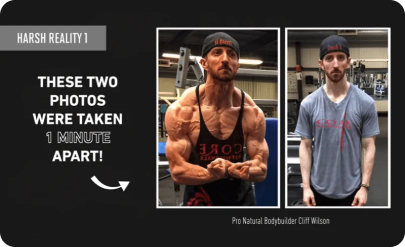There’s a question floating around many gyms that seldom gets answered.
“WHAT’S THE LEAST AMOUNT OF TIME YOU CAN SPEND IN THE GYM AND STILL MAKE GAINS?
Volumes of fitness content, including most of mine, don’t really provide complete responses to this inquiry. For the most part, fitness creators use what I’d call a Maximalist Approach to training. In other words, they train for as long as they need to, to maximize progress.
To illustrate, if there’s a situation where a one-hour workout would get you 98 percent of the results and a two-hour workout would yield a hundred percent of the results, the Maximalist would say you should train for two hours.
However, let’s not be too hasty to jump on board with this thinking because maximalism isn’t always the best.

In fact, even if Minimalism gets less attention, I would say that it’s probably better suited for more people because most people see fitness and bodybuilding as merely part of their lives, not their whole lives.
There are also many people who just straight up don’t enjoy training, at least not yet, and for them, a minimalist approach can provide an easier starting point. My brother is one of these people. He loves golf and many outdoor activities, but he doesn’t like lifting weights and he doesn’t enjoy the gym.
Recently, he started having hip pain and noticed that his strength was lacking at work. As requested, I wrote him a very minimalistic program that only takes him 20 minutes, once a week. This is the exact program he does.

His strength has improved and his hip pain is completely gone! But even if you’re more of a maximalist like me, and you’re okay with bodybuilding consuming a lot of your lifestyle, there’ll be times when you’ll want to focus on other things - work, school, kids, travel, and so on. Knowing how to train like a minimalist will be important knowledge for you to have.
Let’s get started then, with what the scientific literature has to say about the minimum training required to make progress in strength, health, and muscle mass.
STRENGTH
Many are surprised to hear me say that a single Heavy Set done once to three times per week will induce significant strength gains for most people.
To support this, a 2017 Meta-Analysis analyzed nine studies and found that 81 percent of strength gains were made from simply doing one to four sets per exercise per week.

It follows then, that if you want to increase your squat max as time-efficiently as possible, you could do something like this.

If you have the time, you can optionally add one or two back-off sets with lighter weights, which research has shown can boost strength a little bit further. The reason why it really doesn’t take much to see measurable strength gains is because the most important factor for gaining strength is exposure to heavy loads.
For strength, you can get away with doing very little total lifting, as long as when you do lift, it’s reasonably heavy - ideally coming in the one to five reps zone. Incidentally, this is actually how I'm approaching my power lifts at the moment, as I’m focusing more on bodybuilding now. I just squat and deadlift once per week at a high effort and with relatively high loads.
Health
When it comes to health improvements,even less gym time is required than for someone more interested in boosting their strength. You can maximize most health benefits with just 30-60 minutes of weight lifting per week.
This 2022 Systematic Review pulled data from 16 studies on mortality, cardiovascular disease, cancer, and diabetes and found that just 30-60 minutes of lifting per week was enough for “maximum risk reduction”.

In other words, you can see maximum health benefits with just a half hour to an hour of lifting per week. It really doesn’t take much!
MUSCLE GAIN
This third component of progress and training is somewhat more complicated because, unlike strength and health, there’s a much clearer positive relationship between training volume and muscle hypertrophy.
As we unpack the relationship between muscle gain and training, keep in mind the definition of training volume.

For further clarification, if you did one set for your quads per week, that would be considered very low volume and wouldn’t cost you very much time at all. On the other hand, if you did 30 sets for your quads per week, that would be a very high volume and you’d be spending a lot of time in the gym.
I'm guessing that if you’ve been following me or anyone else in the science-based fitness community, you’ve probably heard that around 10 sets per body part per week is a really good target for most people.
Most coaches recommend splitting up those 10 sets across at least two workouts per body part.
For example, you could do five sets for your quads on Tuesday and five sets for your quads on Friday. Regardless of how you split those sets up, the blanket recommendation is 10 sets per muscle per week. More advanced trainees may see marginal gains by going up to 20 sets for some body parts.
At this point, you're likely mauling over a few questions in your head.
Does this imply that 10 sets per muscle per week is the bare minimum?
What if I did nine sets per week instead of 10?
If I did five sets, would I get half the gains of 10 sets?
What if I only did one set per week? Would I make any gains at all?
Well, luckily we do have the science to answer these questions and the results may surprise you.
In the following diagram, the gray bar represents 100 percent of the gains possible if you did 10 plus sets per week. This is your maximum possible gains. Doing just 1-4 sets per muscle per week will get you not 10 percent of the gains, not 20 percent of the gains, but 64 percent of maximum gains.

Pause and think about that for a moment. One set per week is nothing. You can pause your reading right now, take 30 seconds to do a set of bicep curls to failure, and that alone would get you in the range of 64 percent of your bicep gains for the week.
If you do decide to do a little more. Let’s say, 5-9 sets per week that would bring you up to 84 percent of maximum gains.

If that’s not mind blowing enough, it’s actually even better than that for the minimalist because there are a number of strategies we can use to get even more hypertrophic bang for our buck from the limited sets we do. This can close the gap even further and get us ever closer to optimal, while doing less.
Before we dig into those, I should point out that the figures I just discussed do have a few limitations.
-
The majority of the 15 studies in the Meta-Analysis where these results come from, used untrained or “recreationally” trained subjects. Only two of the studies were done on properly trained lifters. Yet, in those two studies, the researchers found no difference between three sets versus one set per session taken to failure. An Alstroski paper even found no statistically significant difference between 3, 6, or 12 sets per week, all taken to failure.
It’s worth noting that there were non-significant trends in favor of the high-volume group.
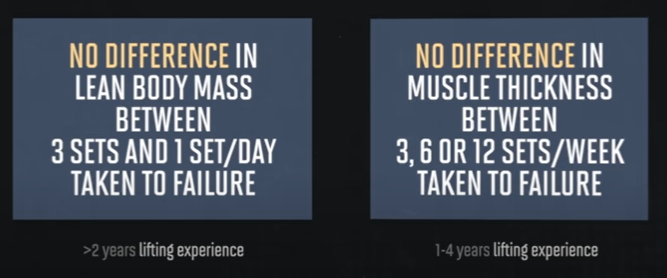
- These studies are all reporting averages. Although on average, people will make 64 percent of maximum gains by doing one to four sets per week, that doesn’t mean that everyone will make exactly 64 percent of maximum gains. For some people, that number will be higher, while for others, that number will be lower.
I should also make it clear that as you gain more lifting experience, you tend to require more volume to keep making progress at a similar rate. However, this doesn’t mean that you can’t still make measurable progress by doing substantially less.
In fact, there are highly veteran bodybuilders that not only make do, but thrive on low-volume protocols. Dorian Yates is one of the greatest IFBB Pro Bodybuilders of all time and this is what his chest training looked like.

He hit chest once a week with just one set to failure per exercise for six to eight reps. For him, that meant a weekly chest volume of merely 4 sets per week. Many struggle to believe that he built that champion chest by doing only four sets per week. But he did! Dorian Yates obviously had some pharmaceutical enhancement on his side, but they’re examples of elite natural minimalists as well.
Jeff Alberts is one of the most decorated natural bodybuilders of all time and this is one of his current pull workouts where he trains back, biceps, and hamstrings.

That’s it. He’ll do some version of this workout twice per week, which means, for the most part, he’s only doing four to eight sets per muscle week. Of course, they’re all very high exertion and masterfully executed, and you can’t argue with his results.
There are also people like Martin Birkin. He inspired a generation of minimalists with his famous F***AROUNDITIS Article explaining how so many people waste their time in the gym by not tracking workouts, doing too much junk volume, including way too much ab training, and spending more time warming up than he does for his whole workout.
So far, I’ve only been talking about making gains, but many people just want to maintain what they’ve already built. There’s nothing wrong with maintenance phases and in this case, you can get away with even less.
This study from Bickel and Colleagues found that subjects were able to maintain their muscle mass for eight months, even when they dropped their volume all the way down to 1/9 of what they were doing at baseline. It’s a lot easier to maintain your gains than it is to build them from scratch.

Allow me to be clear in saying that I love maximalist training. Currently, I don’t mind spending one to two hours a day in the gym, but there are times when I need to use a low-volume minimalist routine. My point with this blog so far is to show that minimalist training is a lot more effective than many people realize, especially if done correctly.
With all this theory in mind, let’s dig into some of the Best Minimalist Training Practices.
#1
PUSH YOURSELF HARDER (than usual)
If you’re going to do a lower quantity of work you need to ensure that that work is high quality. This means you need to execute each and every set as close to perfectly as possible. The lower your volume, the higher your intensity should be to compensate.
#2
USE DROP SETS
In his textbook on the science and development of muscle hypertrophy, Dr. Brad Schoenfeld suggests that to make workouts more efficient, drop sets can be used to increase training volume without substantially increasing session duration.
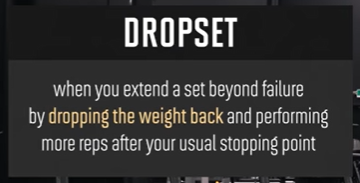
This allows you to get more high-tension reps without killing time by resting. These reps are high tension because the muscle’s already been to failure once.
Generally speaking, after I hit failure once, I’ll drop the weight back by 25-50 percent for my dropset and then I’ll take that weight to failure again, without resting in between.
#3
USE “SENSIBLE SUPERSETS”

Although it’s very common for people to do supersets for the same body part (Eg.super-setting a bench press with dumbbell flyes), research tells us this is a mistake.
A 2020 study found that training performance was decreased when supersets were performed on exercises that trained the same muscles.
However, when supersets are performed on exercises that don’t train the same muscles, both exercises can still be maximized while saving on time. It would then be smarter to superset your bench press with a dumbbell row, for example, since your pecs will be resting while your back is working, and your back will be resting while your pecs are working.
It’s also fine for sensible supersets to be somewhat random. For example, you could superset leg press with lateral raises on a full body day because the muscles on the two exercises don’t overlap.
If you were to break down how you actually spend your time in the gym, you’d find that most of your time is not actually spent training, but rather resting in between sets.
Out of curiosity, I did this myself and tracked a random push day where I recorded the exact amount of time I spent lifting, versus the amount of time I spent resting. This is how it broke down.
The entire workout took me 70 minutes total. Of that 70 minutes, I only spent 14 minutes actually lifting, and I spent 56 minutes resting. That included water breaks, socializing with gym noobs, and taking photos with fans.

This means that a mere 20 percent of my workout was lifting, while 80 percent of my time was spent resting. I may rest a little bit longer than some, but it’s a safe bet that most people will find that at least half their time in the gym is spent resting in between sets.
It’s evident then, that if we want to make our workouts faster, an obvious solution would be to use shorter rest periods. But, there’s a problem with this. Research shows that shorter rest periods tend to be worse for hypertrophy because you can’t fully recover in between sets.
Resting one to four minutes between sets is the typical science-based recommendation.
However, there is evidence showing that if you gradually reduce your rest periods over time, you can still maximize hypertrophy because your cardiovascular endurance will improve, allowing you to recover faster in between sets.
In other words, you can start by resting two minutes between sets in your first week, then rest for 15 seconds less in week two, 15 seconds less again in week three, until eventually, you get down to just one minute rest in between sets.

#4
CUT DOWN ON WARM-UP TIME
Whenever I’m in a time crunch. I’ll just do three to five minutes on the treadmill, a few quick dynamic stretches, and hop right into it. After a quick general warm-up, the minimalist can choose exercises that don’t require as many warm-up sets.
For example, if I do barbell back squats, I’ll generally need four or five warm-up sets before getting to my working weight. After this warm up, I typically still do two or more working sets. That takes a lot of time.

Contrast that to doing a machine hack squat. Here, I’ll only need two warm-up sets before I start the real working sets. You can see how by prioritizing machine exercises that require less warm-up, you can cut down on your total training time as well.
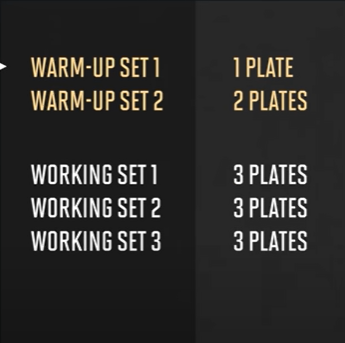
Before we wrap it up, I want to quickly announce that I recently opened up a new program that’s designed to get you in and out of the gym in under 45 minutes.
Studies show that one of the most commonly cited barriers to resistance training is lack of time. With this in mind, I wanted to create a routine that could have people getting effective and intense workouts as time efficiently as possible.
If this sounds like something you might be interested in, you can visit jeffnippard.com to check it out.
The program comes in a 2-day per week, 3-day per week, 4-day per week, and 5-day per-week version, depending on just how busy you are.

As a minimalist routine, it’s appropriate for all levels of advancement, assuming you’re looking to prioritize time efficiency.
If you missed the pre-sale, you’ll just choose which one of the programs you want, based on your schedule. Here is a discount code you can use to save 10%: Essentials10
A summed-up video of this blog is also available on my YouTube channel.
That’s it for this one, guys. Thank you so much! I’ll see you guys all here for the next blog.
References:
Minimum Effective Dose Training Video Series by Eric Helms (MASS):
https://www.massmember.com/products/mass-subscription/categories/2148392859/posts/2150818203
Training Volume for Strength Gains Meta-Analysis:
https://pubmed.ncbi.nlm.nih.gov/28755103/
Training Volume for Health Meta-Analysis:
https://pubmed.ncbi.nlm.nih.gov/35228201/
Training Volume for Hypertrophy Research:
https://pubmed.ncbi.nlm.nih.gov/27433992/
https://pubmed.ncbi.nlm.nih.gov/12423180/
LeanGains Article:
https://leangains.com/fuckarounditis/
Training Volume for Maintaining Muscle Size:
https://pubmed.ncbi.nlm.nih.gov/21131862/
Schoenfeld Textbook:
https://www.amazon.com/Science-Development-Muscle-Hypertrophy-Schoenfeld/dp/1492597678
Superset Research:
https://pubmed.ncbi.nlm.nih.gov/28796130/
Rest Research:
https://pubmed.ncbi.nlm.nih.gov/28641044/
Motivation Research:
https://www.ncbi.nlm.nih.gov/pmc/articles/PMC5968958/

